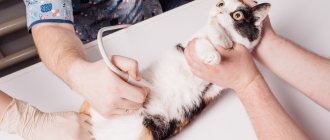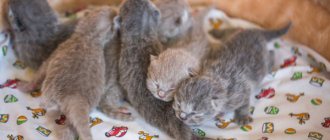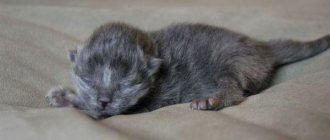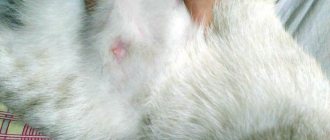In natural conditions, childbirth in felines is usually easy and does not require outside intervention, but in the case of pets, things are not always so rosy. Many cats need the help of the owner, and sometimes an experienced veterinarian, so the process of giving birth to offspring must be carefully monitored. True, not all owners are able to quickly navigate this situation, and most of them have a question: how to deliver a cat so that the kittens are born as painlessly and without complications as possible?
Your pet is pregnant...How to give birth to a cat?
Which cats need help during childbirth?
Ideally, preparation for childbirth in a cat should begin even before pregnancy - she should undergo a preventive examination by a veterinarian, after which the owner needs to find a healthy cat for mating. In addition, you need to take care of proper nutrition, vitamins and medications that the animal may need, and also think about “good hands” for kittens. This most often happens with purebred cats, but outbred pets are usually left to their own devices, their reproduction is not controlled by their owners, and pregnancy becomes a surprise.
Planned pregnancy in a Scottish Fold
The best way to avoid complications and troubles during childbirth is to monitor the health of the cat, especially in the last weeks of gestation. It is better to limit the activity of the expectant mother - she should not climb on high objects and jump from there, run or play for too long. It is recommended to minimize contact between the animal and children and other pets.
If the cat is healthy, the birth of kittens should be normal.
Not all cats require assistance during delivery; sometimes it is enough for the owner to simply observe that the process proceeds normally. Complications can occur in primiparous, weakened or sick females, but sometimes it happens that childbirth is difficult in absolutely healthy individuals. Particular attention should be paid to pets that suffer from cardiovascular and respiratory disorders - it is recommended to take such cats to a veterinary clinic for a cesarean section, and then immediately sterilize them.
In artificially bred cat breeds, childbirth can be difficult.
Artificially bred elite breeds endure childbirth worst of all, and they often lack maternal instinct, so owners sometimes have to take on the role of nanny to care for newborn kittens.
Attention! If a cat was taking any medications before giving birth, its health should be monitored especially closely - after some medications, cats are strictly forbidden to become pregnant, but it is not always possible to keep track of the animal. Even one injection given several months ago can lead to serious complications and even the death of the female.
Stages of the birth process
First, cats go into contractions, which is what muscle contractions are called. They usually happen at night. At the same time, the muscles of the uterus expand and the fetuses move closer to the birth canal. After some time they can be seen. In addition, before the birth of kittens, the mother in labor begins to experience discharge from the genitals. In this case, the animal’s muscles contract in waves. The cat is worried, constantly licking under its tail and straining. Contractions become more frequent, their duration ranges from 6 to 12 hours. The duration depends on the pet’s hormonal levels and the quality of prenatal preparation.
After the baby is born, the mother’s task is to free him from the amniotic sac.
The next stage is the birth process itself. This means that kittens will appear soon. Sometimes giving birth to a cat at home lasts a day or more, and the interval between kittens stretches to 4-6 or even 12-24 hours. If the individual begins to give birth, then during this period the cat’s cervix is fully dilated. Contractions occur with a short interval (10-12 minutes), due to uterine contractions, the water breaks. The uterus, cervix and vagina become one way. The cat pushes, and the fetus comes out. Often, 4 attempts are enough for an animal to give birth to one kitten. Fluid from the amniotic sac helps the kittens move forward. In newborns, the head appears first. But if the kitten walks feet first, then this is normal. Afterwards, the cat chews the bubble, licks it and cleans the cubs of any remaining mucus.
If a cat lambs and gives birth to a dead kitten, then you should try to save its life in the first 15-20 minutes. At the first sign of complications, you should not wait, but it is advisable to call the veterinarian even at night.
How to tell if your cat is going into labor
On average, pregnancy in cats lasts 60-65 days, so if the owner knows the exact date of mating of the female with the cat, it will not be difficult to calculate the date of birth. Otherwise, the onset of hour X can be determined by the following signs:
- the animal loses its appetite, shows aggression, or lethargy (moves reluctantly, sleeps more than usual);
- the female begins to “nes” - to set up a home for the kittens in a secluded corner (under a radiator, in a closet, etc.);
- 1-2 days before birth, the mammary glands swell, and colostrum begins to be released from the nipples;
Swollen mammary glands in a pregnant cat
- on the day of delivery, noticeable changes in behavior occur - the cat becomes restless, constantly meows, hides, or, conversely, follows the owner;
- the animal’s temperature can drop to 37 degrees, and the nose, on the contrary, becomes dry and hot;
- the animal licks itself intensively and a lot, especially the stomach and genitals, and the skin on the stomach contracts and moves as the kittens move towards the birth canal;
- 4-6 hours before the kittens appear, the cat’s posture changes - she begins to arch her back in a special way.
Cats can behave differently during delivery - first-time cats usually experience fear because they do not understand what is happening to them. The owner needs to determine what the expectant mother wants and behave accordingly - if the pet looks invitingly into the eyes and does not leave the person, you need to sit down next to her, talk kindly and calmly, lightly stroke her head and belly.
Before giving birth, cats lick their belly intensively
Some females, on the contrary, want to be left alone, and when a stranger approaches, they begin to show aggression and anxiety - in this case, it is better to leave the cat alone and watch the birth process from afar. The number of babies that can be born at one time varies from 1 to 3, but some “mothers of many children” give birth to 4-6 babies.
For reference: the duration of pregnancy in cats and the number of kittens largely depends on the breed of the animal - representatives of the Siberian breed give birth the fastest, and Persians bear offspring the longest.
How cats give birth
Inexperienced owners have a vague idea of exactly how childbirth occurs in cats. This is a rather long process, starting with the anxiety of the expectant mother and ending with feeding the babies. Several hours pass between these events. At every stage of labor, it is recommended to be close to the woman in labor, or at least monitor her condition. You should always remember that a cat can die during childbirth.
Pet behavior
About two to three days before contractions, the cat's body temperature drops to 37°C. The mammary glands enlarge and become hotter. Despite the physiological characteristics, the owners first of all notice how the cat behaves before giving birth. Typically, a long-awaited event is heralded by four behavioral features.
- Washing. About two days before labor begins, the genitals become swollen and pink. The cat begins to actively lick itself. There should be no allocations.
- Activity. If a cat suddenly gets bored, becomes detached and apathetic, it means that it will be resolved very soon. Do not disturb your pet during this period.
- Appetite. There is often a decrease in appetite. Your pet may not eat anything the day before giving birth. Provide her with drinks as usual.
- Arching. A few hours before contractions, “training” occurs. There are no noticeable contractions yet, but the animal is already arching (hunching over), as during contractions. This is caused by short-term contractions of the uterus. The cat becomes active, restless, loud, and scared. It can get into hard-to-reach places, so it is recommended to limit your personal space. From now on, stay close to your pet while waiting for the birth.
A cat that is strongly attached to its owner will follow him around and scream. It's not just about attracting attention. The pet is in pain, uncomfortable, and is looking for protection and support. It is important to be close to your pet, stroke it, and talk affectionately.
Start of the process
The main signs of the onset of labor in a cat are contractions. Uterine contractions begin several hours before birth and gradually increase. If the spasms can be detected with a palm placed on the stomach, it means that the cat will give birth very soon. Take your pet to the maternity area, calm her down and prepare everything necessary.
Five signs that labor has begun:
- the stomach drops and becomes pear-shaped;
- urination becomes more frequent - the cat goes to the toilet atypically often;
- mucus is secreted - the birth plug in cats comes off in about 24-48 hours;
- the water breaks - the owner may not notice, since the cat quickly sucks up;
- breathing quickens - the cat opens its mouth and breathes frequently with shortness of breath.
Within two hours after strong contractions, the first baby should appear. If your cat has been pushing unsuccessfully for three hours or more, or if an unpleasant-smelling brown fluid is coming out of the vulva, your cat should be taken to the veterinarian. Perhaps the kittens are stuck, lying across, and the cat needs surgery.
Childbirth
If the pregnancy, contractions and the health of the mother in labor are in order, then there is no need to directly deliver the cat at home. However, you should stay close to monitor the process. A first-time cat may panic and become inattentive. The process of giving birth to a kitten can be divided into five stages.
- Passage through the birth canal. The cat pushes, contracting the muscles of the abdomen and thighs. Usually, four to five pushes are enough for the baby to appear.
- Exit outside. The kitten is born in the amniotic sac or its remains. The bubble may burst when pushing, and then a yellowish liquid is released from the vulva. A few hours before birth (you can see the belly moving), kittens usually “line up” in the uterine horns with their muzzles towards the birth canal. But not all fruits have time to do this. Therefore, kittens can be born with their heads and hind legs first.
- Breathing stimulation. The mother bursts the bubble, licks the kitten, freeing the airways from mucus. A squeaking baby is a good sign, it means he is breathing.
- Umbilical cord rupture. The mother gnaws the umbilical cord and eats the afterbirth. Make sure that all the placenta comes out according to the number of kittens. To be sure of your calculations, write it down on a piece of paper. Placenta remaining in the womb can lead to infectious diseases. If there are a lot of kittens, let the cat eat two or three afterbirths, no more. The placenta contains hormones, which is good for pushing and lactation, but can provoke vomiting or cause diarrhea.
- Lactation. Immediately after birth, the kitten attaches itself to its mother's nipple. The cat must accept its baby and start licking it. With multiple births, labor continues.
It happens that a cat, in pain and busy with itself, crushes the newborn kitten or leaves a baby in the amniotic sac. Actions that the mother did not do must be done by the owner for her.
How long labor lasts depends on the number of kittens and the intensity of pushing. Usually all babies are born within six hours. In order not to “forget” anyone, it is recommended to give your cat an ultrasound during pregnancy. The owner will know exactly how many babies are left and will worry in time if labor suddenly stops.
The final stage
The cat's labor ends with the absence of contractions for two hours. The cat calms down, the pushing stops, the stomach drops and becomes soft. Babies begin to actively suck milk. The behavior and physical condition of the mother after childbirth is characterized by the following signs:
- cares for the babies, licks them, feeds them;
- breathes evenly;
- wants to eat and drink;
- wants to go to the toilet;
- changes position in the birthplace.
You should not immediately start feeding your cat after giving birth. Offer your pet water or milk. If the placenta has been eaten, the mother can remain in the “nest” for up to six hours and not eat anything. Place a bowl near the birthing area and feed the mother four to five times a day with regular food. Add milk, cereals, and fish oil to your diet. Place a tray nearby so that the mother is not away from the cubs for a long time.
It is not recommended to touch babies often, otherwise the mother will lose contact with them. After giving birth, move the mother and kittens to soft bedding and clean up the birthing area. Wipe the box with a cloth and change the diaper. Carefully return the family to their place and leave them alone.
How to tell if your cat is ready to give birth
The development and physical condition of each cat is individual, so it is extremely difficult to accurately determine the onset of labor, especially for an inexperienced owner. The most informative signs are the release of the birth plug and water, but a person may not notice them, since sometimes they come out along with urine or feces, and in some cases they are licked by the animal itself. The birth plug looks like a teaspoon-sized clot of white-pink mucus, and the waters have a red-gray tint. If the owner managed to notice them, it means that there are 48-24 hours left before the kittens are born.
The birth plug has come out - it will begin soon...
Preparing to give birth to a cat
You should start preparing to give birth to your pet about a week before the kittens are born. First of all, you should find a suitable box with an open top or a removable lid, put a rag or a disposable diaper there, and under them you can put a washable rubber or cork mat. Ideally, it should be open not only at the top, but also on one side, so that the female, weakened after childbirth, does not have to jump into it.
A house for a pregnant cat can be made from any suitable box
It is advisable to place the box in a place that the cat herself chooses (to do this, you need to note where exactly the cat begins to nest), but at the same time, the “dwelling” should be insulated from cold, heat, children and other pets. You need to place bowls with food and water nearby, and gradually accustom the expectant mother to the new place. As a rule, cats are happy to take care of their future offspring, but if the pet categorically refuses to move into a box, you will have to offer her another option - for example, emptying one of the drawers in the wardrobe.
Attention! The place where the cat will be with her newborn kittens provides comfort not only to the mother in labor, but also to her owner, since sometimes females give birth to offspring in the most inappropriate places: in a wardrobe, under a bathtub or in a bed. “Relocating” a new mother in this case will be extremely problematic, since she will still bring the children back.
What to prepare for childbirth: materials and tools
A day or two before the expected birth, you should acquire materials and tools that may be useful in the process:
- sterile gloves (2-3 pairs) and disposable diapers;
- a small syringe or large syringe for sucking out mucus from the mouth and nose of kittens;
- thick threads for tying the umbilical cord;
- scissors with sharp, disinfected blades in case the umbilical cord needs to be cut;
- clean and ironed pieces of cotton cloth for wiping kittens;
- Vaseline oil and pipette;
- water container;
- cotton buds;
- several disposable syringes with a volume of 2 and 5 ml;
- brilliant green or other antiseptic for cauterizing the umbilical cord.
A baby syringe is necessary for sucking out mucus from the mouth and nose of kittens
In addition to materials and tools, the owner is recommended to acquire medications that will help avoid problems and serious complications.
Table 1. Drugs that are recommended to be purchased before the birth of kittens.
| A drug | What is it used for? | How to use |
| Travmatin | Has analgesic, antimicrobial and anti-inflammatory effects, prevents the development of sepsis and complications after childbirth | Inject the cat with 1 ml at the beginning of contractions, after birth, give one injection per day for three days. For kittens, drop 3 drops into the mouth immediately after birth and for three days in the postpartum period |
| Gamavit (Aminovit, Microvitam) | Vitamin remedy for restoring the body and normalizing labor | Inject 1 ml subcutaneously once a day for a week before giving birth. At the beginning of contractions, give 1 injection (1 ml), then, if necessary, 0.3-0.5 ml. Kittens should put 3 drops in their mouth after birth and in the first 3 days of life. |
| Mastomethrin | Eliminates inflammation, prevents mastitis and other complications | 1-2 injections of 1 ml of the drug after childbirth with an interval of 24-48 hours |
| Oxytocin | Stimulates contractions during cessation of labor | 0.2-0.3 ml at the withers strictly between contractions or after they subside |
| Calcium gluconate | Normalizes labor, prevents and eliminates eclampsia | 1 ml intramuscularly 2-3 times a day |
In addition, you need to find out the coordinates of the nearest veterinary clinic and think about how to quickly get to it in an extraordinary situation.
How long does it take for a cat to give birth?
Normally, a cat’s labor lasts 5-10 hours, the maximum time being 24 hours from the moment contractions begin. A few minutes or a few hours may pass between the birth of kittens - as a rule, the longest interval is observed between the birth of the first and second kitten, with the rest appearing one after another.
Childbirth in a cat can last from several hours to a day.
How long does labor last and how does it go?
Most owners are eager to know how long a cat’s labor lasts, because the information is extremely important. If you know exactly how long a normal birth should last, you can easily notice deviations from the norm and take the necessary actions. If some labor lasted faster than the current one, it’s time to call the veterinarian if you yourself do not have the necessary experience. But we note that the firstborn suffers more in this process.
The first stage of labor usually lasts no more than 12 hours. Since cats are very emotionally attached to their owner, his presence during childbirth will significantly help the animal, since it will not worry when someone who can be trusted is nearby.
The first stage is contractions, during which the fetus moves along the paths to freedom. The second stage is the birth itself, during which the kittens are born. If the first phase still does not end and lasts more than a day, then you should call a veterinarian - this means that serious problems have arisen, due to which the fetus cannot move towards the exit.
Stages of labor in cats
The process of delivery in cats takes place in three stages, and the duration of each of them depends on the age, general condition of the animal and the number of births in the anamnesis. Females who have had several successful pregnancies usually give birth very quickly, while in primiparous individuals the process may be delayed.
- At the first stage, the cat begins to experience contractions - involuntary contractions of the uterus, which push the kittens from its cavity into the birth canal, and then out. The animal becomes restless, often runs up to the prepared box, follows the owner, during contractions it can scream unnaturally and breathe with an open mouth, and sometimes there is slight bleeding from the genitals. If you look closely at the cat's belly, you will notice the active movement of the kittens. The duration of the first stage is several hours, but in primiparous animals it can increase to 24-36 hours.
- The second stage is characterized by intensified contractions and the birth of kittens - the female lies on her back or side, breathes heavily with her open mouth and strains greatly, helping the offspring to exit the vagina. First, the fetal sac with the baby appears from the birth canal, then its membrane bursts, a small amount of liquid flows out, and then the kitten itself comes out. Duration – from 5 minutes to half an hour.
These kittens were born quite recently
- During the third stage, the fetal membrane (placenta) comes out of the uterus - it usually appears immediately after the birth of the next kitten, but sometimes it can be delayed.
For reference! The behavior of a cat during childbirth and the course of the process are purely individual indicators, so it is quite difficult to develop a clear plan of action, and the owner must be prepared for any surprises.
Video - How to give birth to a cat
Labor has begun!
When your cat has her first contractions, she may scream loudly. This means the process has begun. But before the first newborn furbaby is born, the kitty has a lot to deal with. Much also depends on the behavior of the owner. The animal is already helpless and scared, and if household members run around and loudly discuss what is happening, this will cause great discomfort and suffering to the cat.
Childbirth in a cat goes through several stages:
- The waters are receding.
- The cervix and birth canal open.
- The first cub appears (each next kitten will come out after 15-30 minutes).
- The placenta emerges from the uterine cavity.
Cat birth is not uncommon, but the pet needs to be taken seriously. A loving owner will definitely go to the pharmacy in advance and buy the following products:
- sterile gauze;
- small towel;
- scissors;
- pipette;
- warmer;
- baby cream or Vaseline.
How to distinguish normality from pathology, and how to help your cat
Normally, the most important part of childbirth occurs as follows: the kitten emerges from the birth canal head first, in the amniotic sac, which ruptures on its own or is ruptured by the cat. After this, the mother intensively licks the baby, clearing it of any remaining amniotic fluid, gnaws the umbilical cord, eats the afterbirth that follows the kitten, and places the baby closer to the stomach so that it begins to suck colostrum. The birth of one baby takes about 15 minutes.
Normally, a cat gnaws the umbilical cord itself and cares for newborns.
If everything happens this way, the newborns begin to squeak, move and suck milk, and the cat looks normal, the owner can only count the cubs and the placenta - they need to be equal in number (the placenta remaining in the uterus can cause an inflammatory process and other complications). Help for a giving birth cat is only necessary for complications, which can be mild or severe - in the first case, the owner of the animal can cope on his own, and in the second, the help of an experienced veterinarian is required.
How can I help you?
If the cat has not given birth before, then the process does not always go correctly: she does not understand what is happening, and childbirth is painful. When giving birth for the first time, during contractions the pet begins to look under the tail, not knowing why such pain occurs. It is important to stay close to your pet all this time, because the animal’s maternal instinct may disappear due to spasms. Then the owner must cut the film and the umbilical cord himself, treat the cut with an antiseptic and free the kittens. After a while, the cubs are cleared of mucus using a rubber bulb. Next, the owners place the kittens under the mother's nipple. At this stage, the cat should usually begin to lick the babies herself. Next, if the mother has finished cleaning the children, she feeds them. After a few months, you can find out and determine what sex the cats are.
The onset of labor: what you can do to help
At the beginning of labor, the cat requires practically no assistance - the owner can talk gently to the woman in labor, and also lightly stroke her back and stomach. This will calm the animal and at the same time stimulate labor. For individuals with long hair, you can loosely wrap a piece of gauze around the base of the tail so that the kittens do not get confused, and it is easier to control the process. If the female becomes restless or aggressive, it is better to leave her alone and watch the birth from the side.
The cat should be lightly stroked on the back and belly
Induction of labor
If labor weakens or stops, you should not panic in advance - most likely, it will resume after some time. The physiological characteristics of cats are that after the birth of one or two cubs, labor may subside and resume only after a few hours (sometimes the interval is 12-24 hours). To speed up the process, you can gently massage the mother's belly and nipples.
Oxytocin and other labor inducing agents should be used cautiously
Attention: Oxytocin should only be used as a last resort, after consulting with a veterinarian - improper use of the drug can lead to the death of kittens and the cat itself.
Problems during childbirth that you can solve on your own
As soon as the second, most important phase of childbirth begins, the cat’s owner must be nearby at all times in order to notice possible pathologies in time and provide assistance to the animal. With regular contractions, you can give an injection of calcium gluconate (1 ml) at 3-4 different points on the cat’s body, and another injection after birth - this will help the cat endure contractions more easily and prevent eclampsia. The need to administer other drugs (Travmatin, Gamavit, etc.) depends on the condition of the animal, the presence or absence of problems during the delivery process.
Help for a giving birth cat is only necessary if there are complications.
What to do, if:
- The kitten is stuck in the genital tract and comes out with its back or tail first. This happens when the fetus is malpresented or in situations where the kitten is quite large. If left to chance, the baby may suffocate in the birth canal, so the owner needs to put on disposable gloves, lubricate his fingertips with Vaseline and carefully pull him out. It is better to pull not by the paws (there is a high risk of breaking or damaging them), but by the skin on the withers, grabbing it with three fingers.
- The amniotic sac did not rupture. In such cases, the cat must rupture the amniotic sac itself, but sometimes it cannot perform its functions due to inexperience or weakness, and then the “obstetrician” must release the kitten. The bubble should be broken close to the baby's nose, being extremely careful not to scratch its delicate skin.
- The cat did not bite the umbilical cord. Females do not bite the umbilical cord immediately - usually after the baby is completely cleansed of tissue and water residues. If this does not happen 15-20 minutes after the baby comes out, you need to cut it yourself. To do this, the umbilical cord is tied with a clean thread, 4-5 cm away from the kitten’s body, after which it is cut from the side of its abdomen next to the constriction. After completing the procedure, you should make sure that the cat begins to lick the incision site - if she refuses to do this, you need to cauterize it with an antiseptic.
Females do not immediately bite the umbilical cord
- The cat does not care for newborns. Licking kittens immediately after their birth is necessary not for reasons of hygiene, but for the start of normal life of the offspring. If the cat has not started grooming the kitten, you need to rupture the amniotic sac, cut the umbilical cord, then wipe the baby with a clean cloth and use a syringe to remove mucus from the nose and mouth. Next, it is advisable to place it on the cat’s nipples - it will begin to drink colostrum, massaging the stomach and nipples with its paws, and the whole process will go faster.
- The kitten is breathing unevenly or not breathing at all. Most often this happens in cases where he inhales a certain amount of amniotic fluid. The kitten should be picked up, held head down for a few seconds and gently shaken - after which it should squeak. To make sure that the baby is in normal condition, you can examine his tongue - it should be pink, which indicates normal saturation of the body with oxygen.
The kitten should be picked up and its viability checked
- The placenta does not come out of the uterus. If at least one placenta remains in the genital tract and does not come out approximately an hour after the birth of all kittens, you need to carefully pull it out by wrapping your fingers in a clean bandage.
After all the kittens have been born, you need to remove all garbage and dirty diapers, cover the box with clean bedding if necessary, and make sure that all the babies have access to their mother's milk and are sufficiently active. If the cat is in no hurry to show maternal instinct, runs away from the kittens, does not want or for some reason cannot feed them, you should buy a special milk formula and a feeding device (sold in veterinary pharmacies).
After giving birth, you need to make sure that the cat and kittens are healthy
Important! As a rule, cats eat the afterbirth that comes out after the birth of a cub - this is an instinctive action that is embedded in the genes of the animal from the time of living in the wild, when the new mother could not leave her offspring to find food for herself. You should not allow the animal to eat more than two afterbirths - this can lead to serious digestive upset.
How to feed a newborn kitten if the mother cat refuses to do so
What to do when childbirth has complications
While minor problems during childbirth in a cat can be dealt with on your own, serious complications require immediate medical intervention. It is necessary to urgently call the veterinarian or take the woman in labor to the clinic in the following cases:
- the female carries the babies for more than 70 days, and there are no signs of their birth;
- the first stage of labor lasts more than 24 hours;
- strong contractions last more than an hour, but the baby does not come out;
- the newborn is stuck in the genital tract, and independent attempts to remove it were unsuccessful;
- strong discharge from the genitals appears (bloody, purulent, liquid with an unpleasant odor);
- the cat’s temperature has risen above 39.5 or dropped below 37 degrees;
- the animal makes no attempt to push the kitten out, lies motionless and breathes weakly.
In case of serious complications, it is better to take the cat to specialists
If any troubles arise during the delivery process that the owner cannot cope with on his own, it is better to contact a specialist - inept or incorrect actions can cause serious harm to the animal.
Childbirth in cats is a natural process that usually does not require human intervention, and the correct behavior of a female is inherent in her genes by nature itself. However, the presence of a beloved owner will provide good moral support for the animal, as well as a guarantee that the babies and their mother will endure this important process normally.
How do you know if your cat is about to give birth?
Animal behavior
Offspring appear on the 65-67th day after conception.
The first signs that a cat is about to give birth are manifested in its behavior. The pet is looking for a secluded place in the house; it can climb into closets and boxes. This suggests that the pet is looking for a protected corner where it is safe to give birth to kittens. At the same time, a domestic cat can suddenly become aggressive or affectionate. A pregnant cat demands attention from its owners and constantly follows them.
Physical signs
On the eve of such an important event, the female’s mammary glands noticeably enlarge.
If a cat is about to give birth, then she suddenly loses her appetite, constantly asks for water or, conversely, refuses water. On palpation, you can feel the mammary glands enlarged. Before giving birth (2-3 days), the mucous plug begins to come off, so the cats lick the perineum. The owner notices swelling of the external genitalia, and sometimes a yellowish secretion appears. The day before the kittens are born, the pet’s body temperature drops to 37 degrees, and 1 hour before the birth begins, the animal begins to feel lethargic. This means it's time to give birth.











